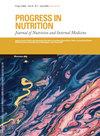Influences of Physalis peruviana L. and Lupinus albus L. fruits extracts on the levels of some biochemical parameters in brain and muscle tissues of type II diabetic rats
4区 医学
Q4 Agricultural and Biological Sciences
引用次数: 1
Abstract
New functional foods are increasingly sought to improve the treatment of diseases related to glucose and lipid metabolism. The present study was designed to investigate the possible antidiabetic and antioxidant effects of goldenberry and lupin on brain and muscle tissues of streptozotocin-induced type II diabetic rats. Type II diabetes was produced in albino rats by the streptozotocin injection. Wistar albino rats were divided into four groups, each one containing 10 rats: non-diabetic control group, STZ- type II Diabetes group, STZ- type II Diabetes+goldenberry group, and STZ- type II Diabetes+lupin group. After one week from the injection, goldenberry and lupin were injected to rats for 2 months. Malondialdehyde, glutathione, cholesterol, and fatty acid levels, which are signs of lipid peroxidation, were measured in brain and muscle tissues. In type II diabetes, malondialdehyde increased compared to the control group. Glutathione decreased in the both tissues and all of the streptozotocin-induced diabetic groups. In type II diabetes, brain cholesterol levels decreased. Treatment with similar doses of goldenberry and lupin significantly reduced oxidative stress, augments antioxidant system and altered fatty acid metabolism in these tissues, thereby maintaining favourable fatty acid distribution affected by diabetic complications. These results validate the use of goldenberry and lupin fruits as a treatment against diabetes mellitus and its complications and suggest it is suitable to continue studies for its safe therapeutic use.紫Physalis L.和Lupinus albus L.果实提取物对II型糖尿病大鼠脑和肌肉组织生化指标的影响
人们越来越多地寻求新的功能性食品来改善与葡萄糖和脂质代谢相关的疾病的治疗。本研究旨在研究金浆果和羽扇豆对链脲佐菌素诱导的II型糖尿病大鼠大脑和肌肉组织可能的抗糖尿病和抗氧化作用。注射链脲佐菌素在白化大鼠中产生II型糖尿病。Wistar白化大鼠分为四组,每组10只:非糖尿病对照组、STZ-Ⅱ型糖尿病组、STZ-Ⅱ型糖尿病+goldenberry组和STZ-II型糖尿病+lupin组。注射一周后,给大鼠注射goldenberry和羽扇豆素,持续2个月。在大脑和肌肉组织中测量了丙二醛、谷胱甘肽、胆固醇和脂肪酸水平,这是脂质过氧化的迹象。在II型糖尿病中,与对照组相比,丙二醛增加。谷胱甘肽在两种组织和链脲佐菌素诱导的所有糖尿病组中均降低。在II型糖尿病中,大脑胆固醇水平下降。用类似剂量的金浆果和羽扇豆进行治疗可显著降低氧化应激,增强抗氧化系统,改变这些组织中的脂肪酸代谢,从而保持受糖尿病并发症影响的有利脂肪酸分布。这些结果验证了金浆果和羽扇豆果实作为治疗糖尿病及其并发症的用途,并表明其安全的治疗用途适合继续研究。
本文章由计算机程序翻译,如有差异,请以英文原文为准。
求助全文
约1分钟内获得全文
求助全文
来源期刊

Progress in Nutrition
医学-营养学
CiteScore
1.40
自引率
0.00%
发文量
0
审稿时长
>12 weeks
期刊介绍:
Progress in Nutrition was founded in 1999 as an independent magazine, a multidisciplinary approach, dedicated to issues of nutrition and metabolism.
 求助内容:
求助内容: 应助结果提醒方式:
应助结果提醒方式:


